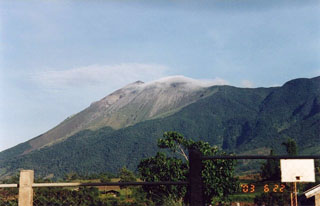Report on Kanlaon (Philippines) — October 1989
Scientific Event Alert Network Bulletin, vol. 14, no. 10 (October 1989)
Managing Editor: Lindsay McClelland.
Kanlaon (Philippines) Mild ash ejections to 1,200 m
Please cite this report as:
Global Volcanism Program, 1989. Report on Kanlaon (Philippines) (McClelland, L., ed.). Scientific Event Alert Network Bulletin, 14:10. Smithsonian Institution. https://doi.org/10.5479/si.GVP.SEAN198910-272020
Kanlaon
Philippines
10.4096°N, 123.13°E; summit elev. 2422 m
All times are local (unless otherwise noted)
Since 25 October, mildly explosive ash ejections, to as much as 1,200 m above the summit, have occurred almost daily. As of 3 November, 29 voluminous gray plumes had deposited ash over the entire crater area and the upper SW and S slopes. No significant seismicity preceded emissions, which were accompanied by small-amplitude explosion earthquakes and tremor episodes. Iseismicity;explosion earthquake Total sulfate concentrations of hot springs NW of the crater have increased since March, from 90 to 135 ppm in the aquapool, 300 to 365 ppm in the mudpool, and 180 to 250 ppm in the sulfur spring.
Geological Summary. Kanlaon volcano (also spelled Canlaon) forms the highest point on the Philippine island of Negros. The massive andesitic stratovolcano is covered with fissure-controlled pyroclastic cones and craters, many of which are filled by lakes. The largest debris avalanche known in the Philippines traveled 33 km SW from Kanlaon. The summit contains a 2-km-wide, elongated northern caldera with a crater lake and a smaller but higher active vent, Lugud crater, to the south. Eruptions recorded since 1866 have typically consisted of phreatic explosions of small-to-moderate size that produce minor local ashfall.
Information Contacts: PHIVOLCS.

